Planting bulbs for spring: a complete guide for a stunning display
We've got all the advice you need on when to start planting bulbs and how to do so, so you can enjoy beautiful blooms throughout spring
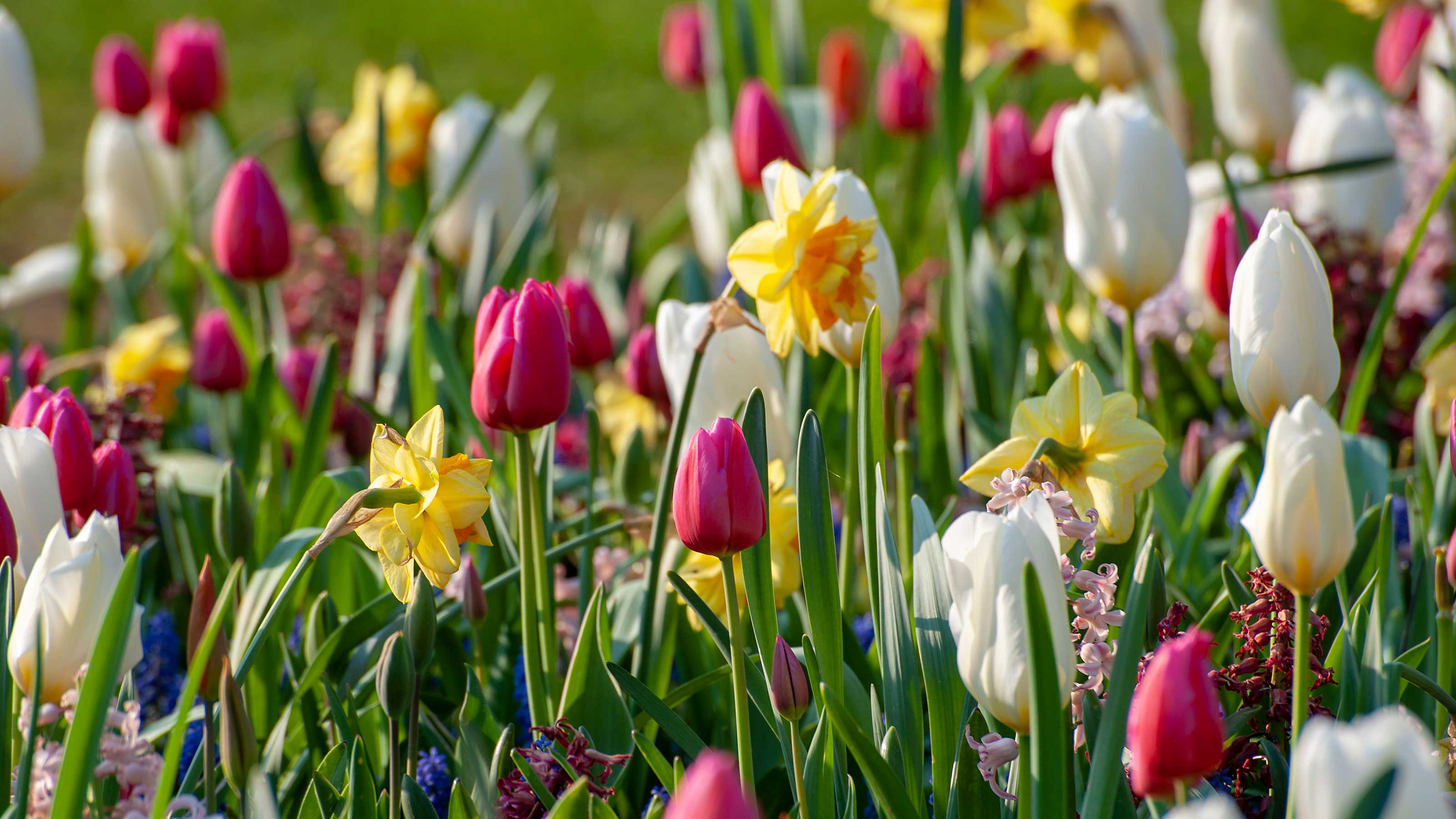

Holly Crossley
Planting bulbs for spring is a great way to plan for a colorful garden next year. And it's so easy to do, even the most inexperienced of gardeners can get involved. Bulbs are also inexpensive, come in a range of beautiful varieties, and are super versatile: you can grow them in beds and borders, containers, window boxes, and even hanging baskets.
Autumn is the perfect time to learn how to plant tulips, daffodils, and all the other springtime favorites, and perhaps some more unusual types, too. It's crucial to get bulbs planted before the ground freezes, so it's a good idea to start planning as soon as you can.
We've rounded up tons of useful tips on planting bulbs to help you get started with your own show-stopping display.
Everything you need to know about planting bulbs
From how and when to plant bulbs for spring to the best picks for scent or shade, you'll find all the info you need below.
When should you plant bulbs for spring?
Spring bulbs should be planted in autumn, before the ground is frozen. It's generally best to get your daffodils, crocuses, and hyacinths planted in early fall. Tulip bulbs can be planted a little later in the season which helps them resist tulip fire.
If you're 'forcing' bulbs indoors, these are best planted in early autumn, too – especially if you want them to bloom in time for Christmas. But, double-check the packet for your chosen variety to be sure.
Snowdrops can be planted from mid to late fall. The bulbs are prone to drying out, so get them in the soil as soon as possible after buying them. However, for best results, snowdrops should be planted 'in the green' (when they still have their foliage), in early spring.
You can also plant hardy summer bulbs, such as alliums and crocosmia, from early to mid-fall.
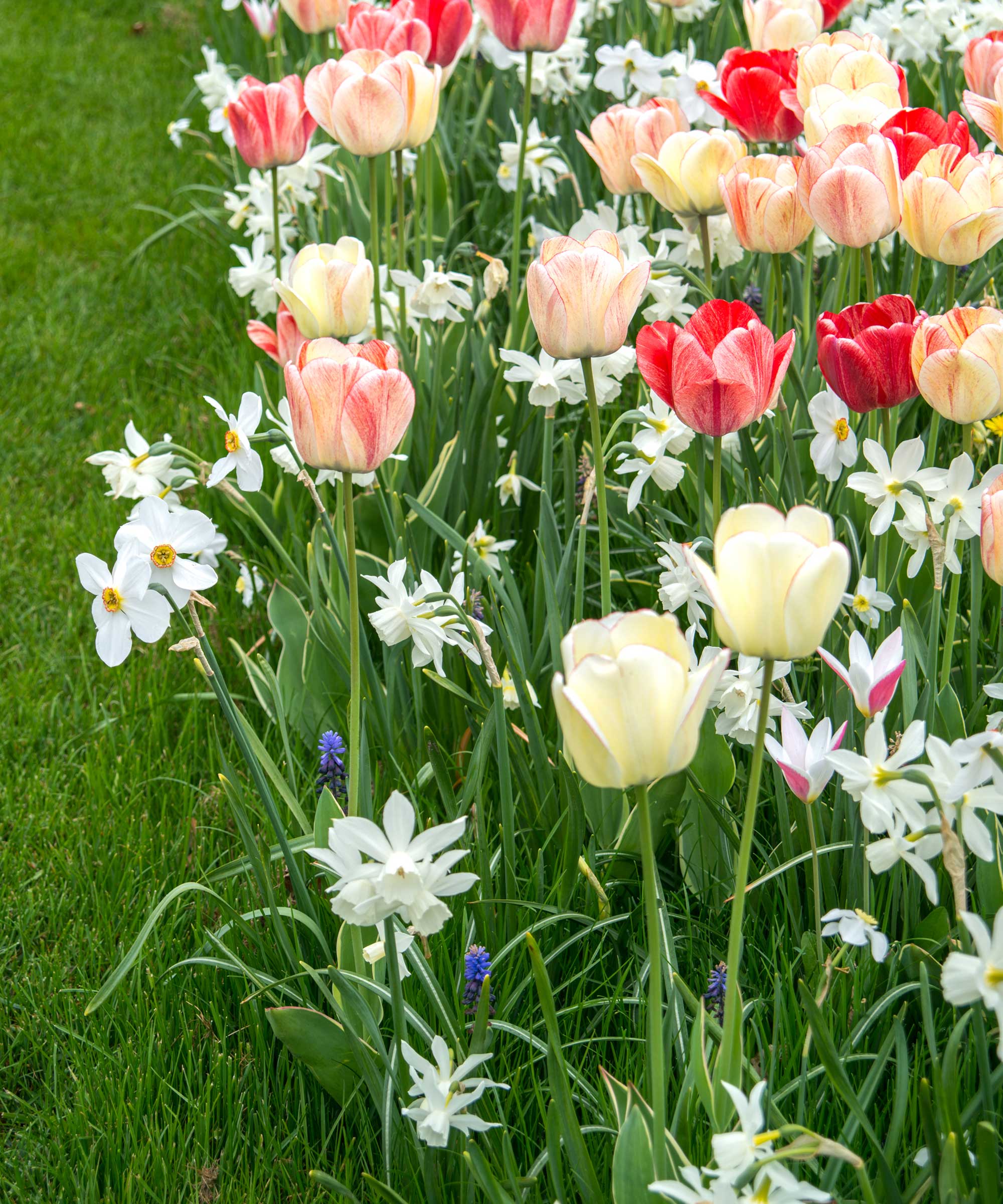
Bulbs can be planted into the lawn for a natural look
How do you plant bulbs in containers?
Bulbs are brilliant for brightening up a patio or deck in a spring container. And it's easy to plant them in this way:
- Use multi-purpose compost and add a little horticultural grit to improve drainage.
- For a beautiful and full display, pack in as many bulbs as you can fit. Avoid allowing them to touch, though – instead, space them around a bulb's width apart.
- If you're opting for a mix of varieties, plant a bulb lasagne by putting the biggest bulbs at the bottom and the smallest ones on top, layering them up with soil in between.
- Once you've finished planting your bulbs, water them once and then regularly when they're in active growth, suggests the RHS. Be careful not to overdo it though, which can lead the bulbs to rot.
- Squirrels love to forage for bulbs in containers. Place some chicken wire or other mesh cover over the pot once you've planted it up to stop them from digging. As soon as the green shoots of the bulbs start to show, you can remove it.
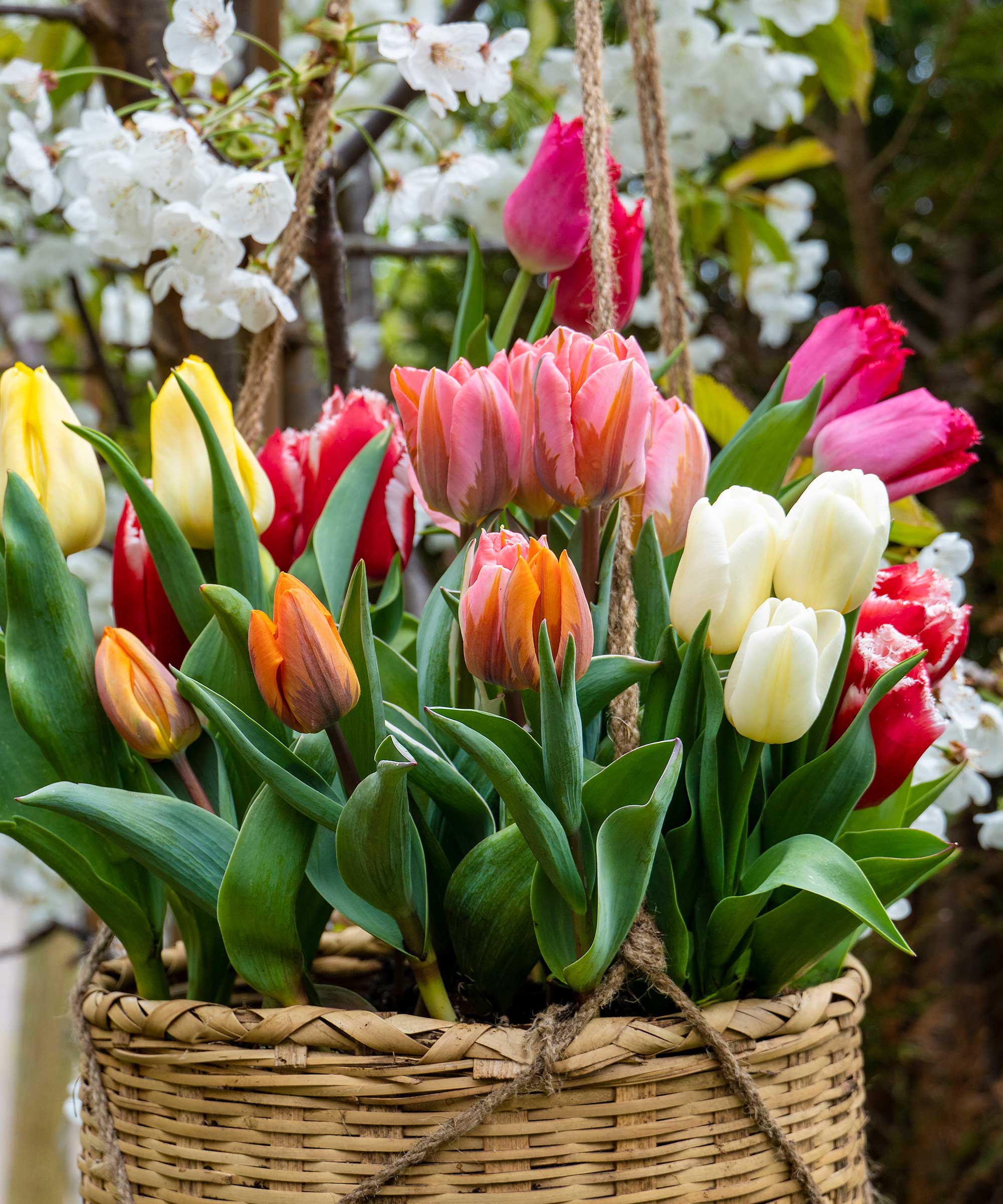
Brighten up hanging baskets
How do you plant bulbs in borders?
Bulbs should definitely be on the list when considering flower bed ideas. They bring a welcome burst of color and interest after the cooler season.
- Aim to plant bulbs in clusters of at least six or seven for the best effects.
- Dig a hole to the right depth and width to fit your bulbs – if you're unsure, double-check the packet, but a general rule is to plant each bulb at a depth of around two to three times its height.
- Space them out a little further apart than you would in containers, more like twice the bulb's width between each.
- Remember to plant them the right way – pointy shoot facing upwards.
- Once you've put the bulbs in the hole, cover them with soil and gently firm them in. Watering isn't normally necessary, unless the soil is very dry.

This display will bring joy to any onlooker
How do you plant bulbs in lawns?
Planting spring bulbs in lawns is a great way of brightening up large areas of grass or difficult-to-plant areas such as steep banks.
Choose naturalizing bulbs such as snowdrops, many types of daffodils, Scilla siberica, Fritillaria meleagris (snakes' head fritillaries) or Crocus tomasinianus that will multiply naturally on their own, increasing in number year after year.
- To create a natural look, scatter the bulbs on the grass to be planted where they fall.
- Use a bulb planter, available on Amazon, for large bulbs such as narcissus or tulips. Small bulbs can be planted in holes made by a garden fork or sharp stick.
- Remove the turf plug and carefully insert the bulb. Use the soil from the plug to gently firm in and replace the turf plug on top.
- Alternatively, several bulbs can be planted in a large hole. Using a spade, cut the turf in the shape of the letter 'H' to a depth three times the height of the bulb. Then, carefully peel back the turf, lightly fork the soil underneath to break up any that's compacted, scatter the bulbs, then replace the turf flaps. Firm in and water well to ensure the turf keeps growing.
Try mixing crocus bulbs with daffodils for a varied and colorful springtime show that lasts for months.
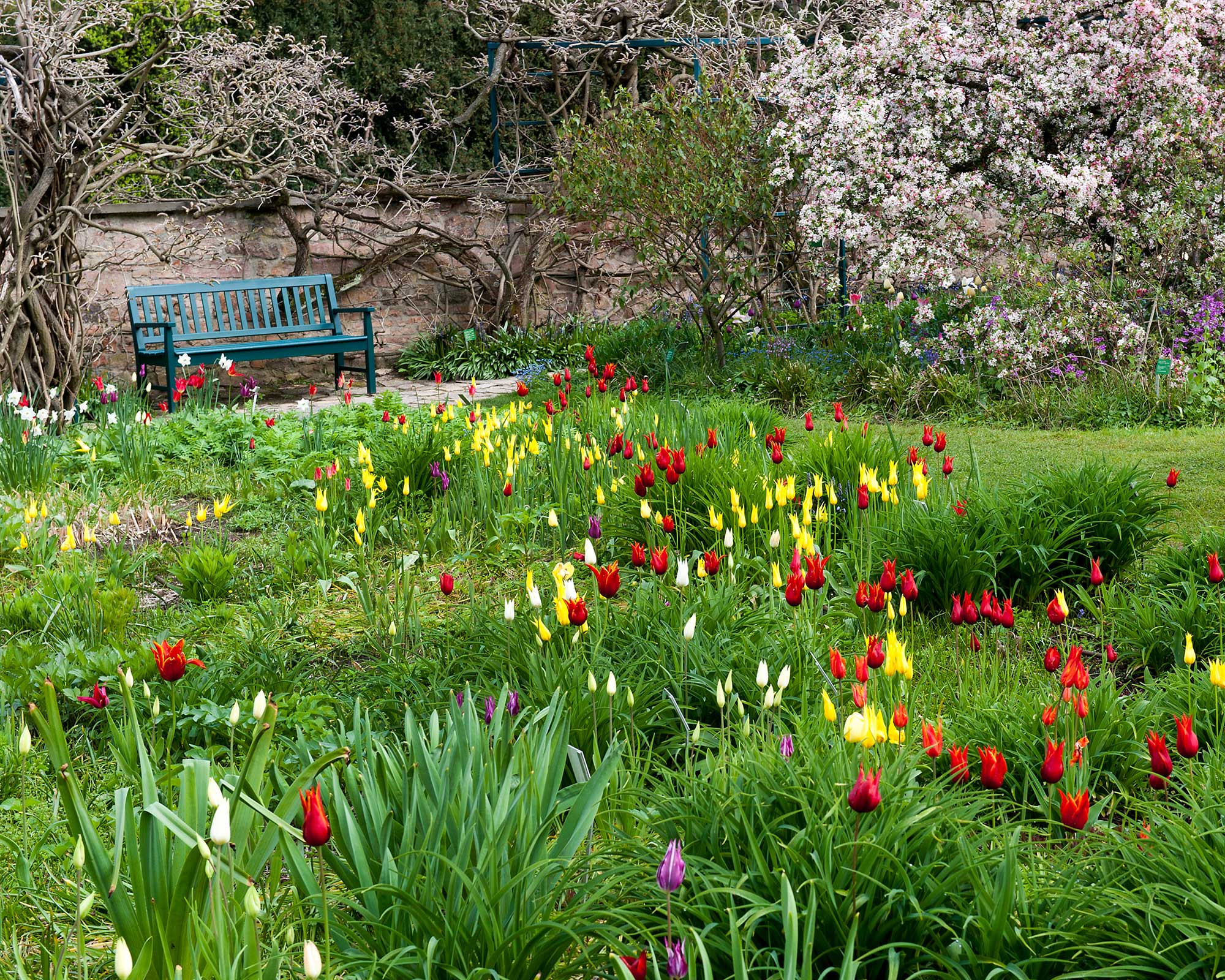
An array of brightly-colored tulips will breathe new life into the garden
How deep should bulbs be planted?
Most bulbs like to be planted two to three times their own height. It can vary though, so always check the instructions on the packet.
If you're 'forcing' bulbs indoors, they can be planted much shallower, with the tips of their shoots poking just above the soil level.
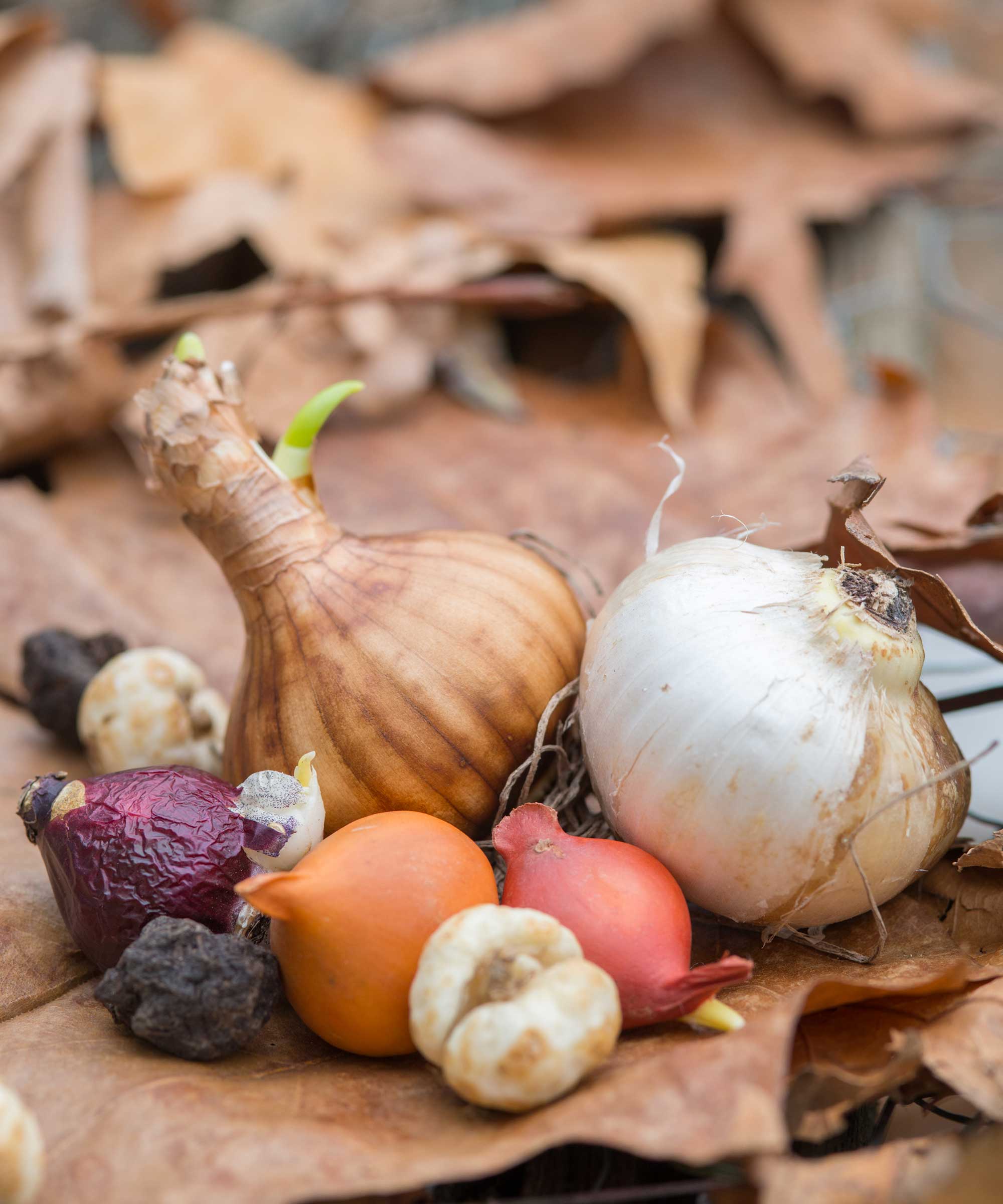
Bulbs come in all shapes and sizes
What are some more unusual bulbs to try?
Tulips, daffodils, and hyacinth bulbs are all classic picks for the spring garden, and for good reason. But there are some alternatives to try if you fancy adding something a little different to the mix this year.
For containers, Graham Rice, a gardening expert of Amateur Gardening, recommends Bellevalia paradoxa, which he describes as 'like grape hyacinths on steroids.' They have dense, pointed spikes of tiny green-tinted blue buds opening to rich blue bells tipped in yellow. 'In pots, they show off their delicate detail,' he adds. They grow to around 9in (23cm).
If you're able to provide a little winter shelter, you could also try ixia, which has upright stems lined with small flowers in a rainbow of shades. Graham suggests starting them off in a greenhouse and then moving pots to the patio as the buds open.
Another one to try for your container display is ipheion. 'These hardy, ground-covering bulbs look especially good in a pot as the mass of slender foliage droops over the sides,' says Graham. 'Wisley Blue' has starry blue, fragrant flowers.
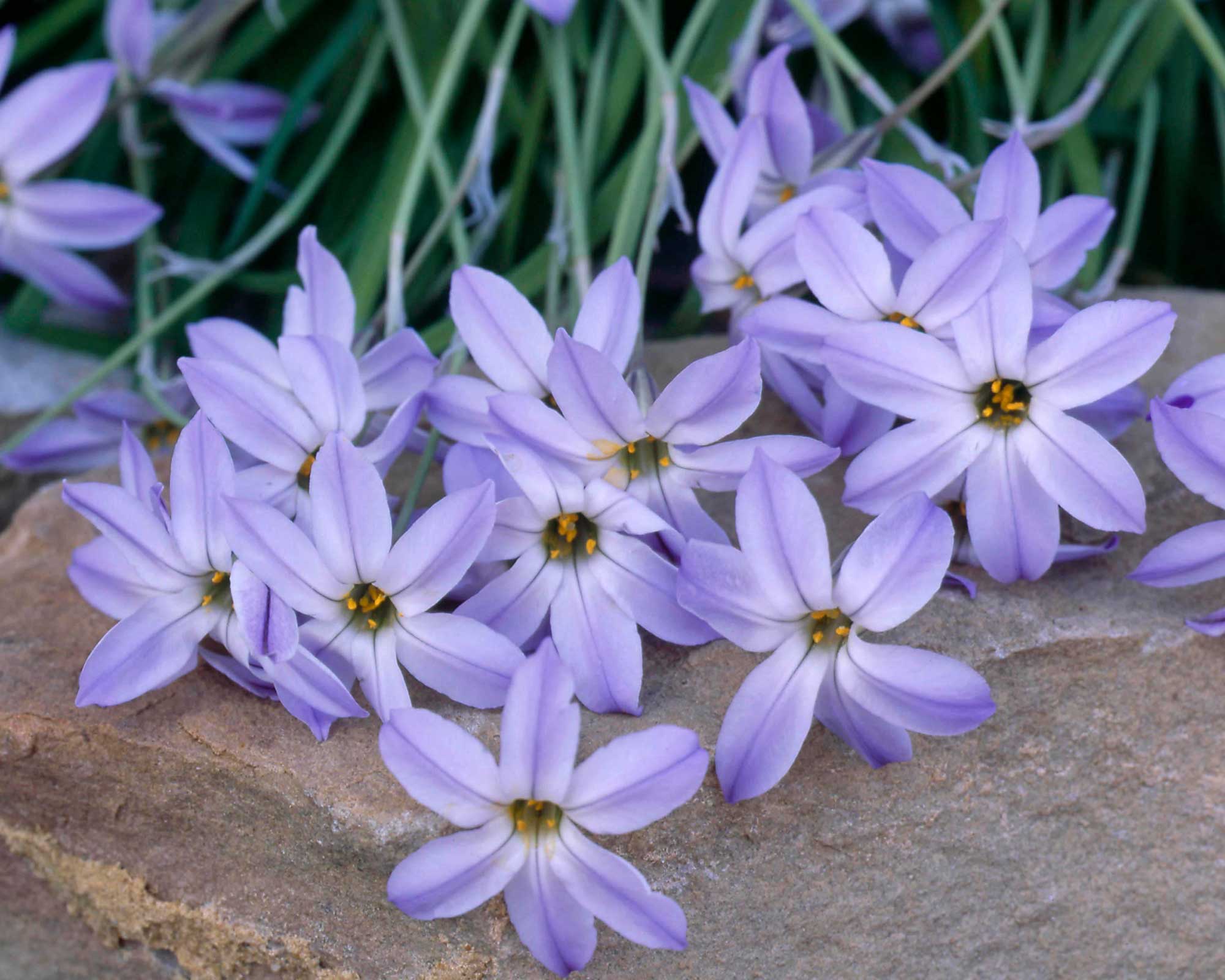
Ipheion unilforum 'Wisley Blue'
For sunny borders, camassia makes a lovely addition, with their late-spring spikes of starry flowers in a huge range of bright blue shades, plus white, purple and pale pink. They're also very pretty naturalized in grass, adds Graham. Leucojum aestivum is another good choice. Long-flowering, it carries up to eight large white bells, with green spots at the tips and is gently chocolate scented.
You could always opt for interesting twists on the traditional bulbs, too. Graham suggests hoop-petticoat daffodils, multi-headed types of tulips and multiflora hyacinths that produce three or four flower stems from each bulb, instead of one.
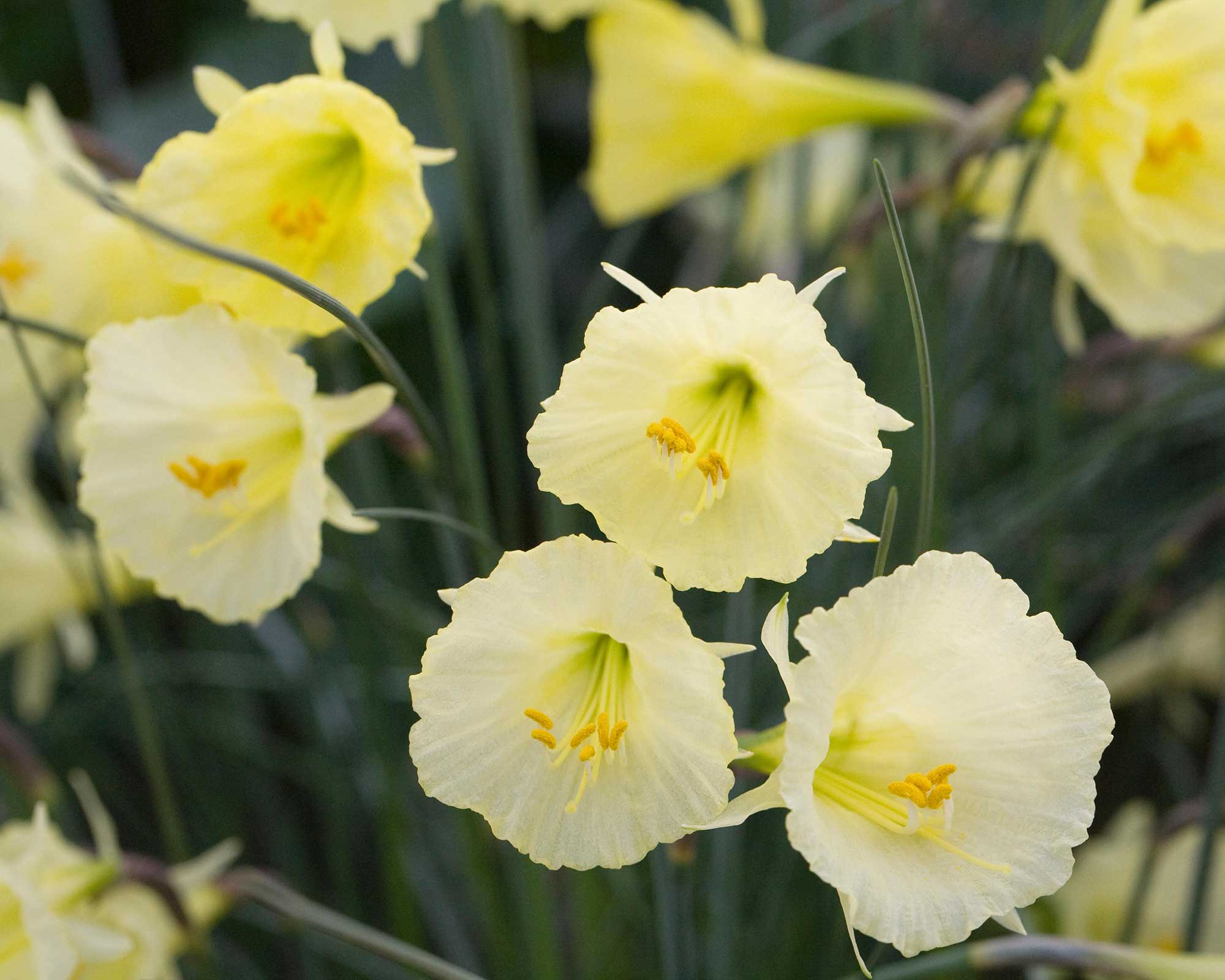
Try a twist on the classic with hoop-petticoat daffodils
What are the best bulbs for cut flowers?
Some of the best spring bulbs make fantastic cutting garden flowers, including the stalwarts of daffodils, tulips and hyacinths. There are so many options to choose from, but some of our favorites include the peachy ruffled 'La Belle Epoque' tulip; the fragrant, double-bloomed 'Cheerfulness' narcissus; and the vivid-purple 'Woodstock' hyacinth which has a gorgeous perfume.
For something that flowers a little later in the year, try brodliaea, suggests Graham Rice. Otherwise known as triteleia, they look a little like miniature agapanthus and flower in summer. They come in shades of blue, white, or, in the case of 'Foxy' are bicolored.
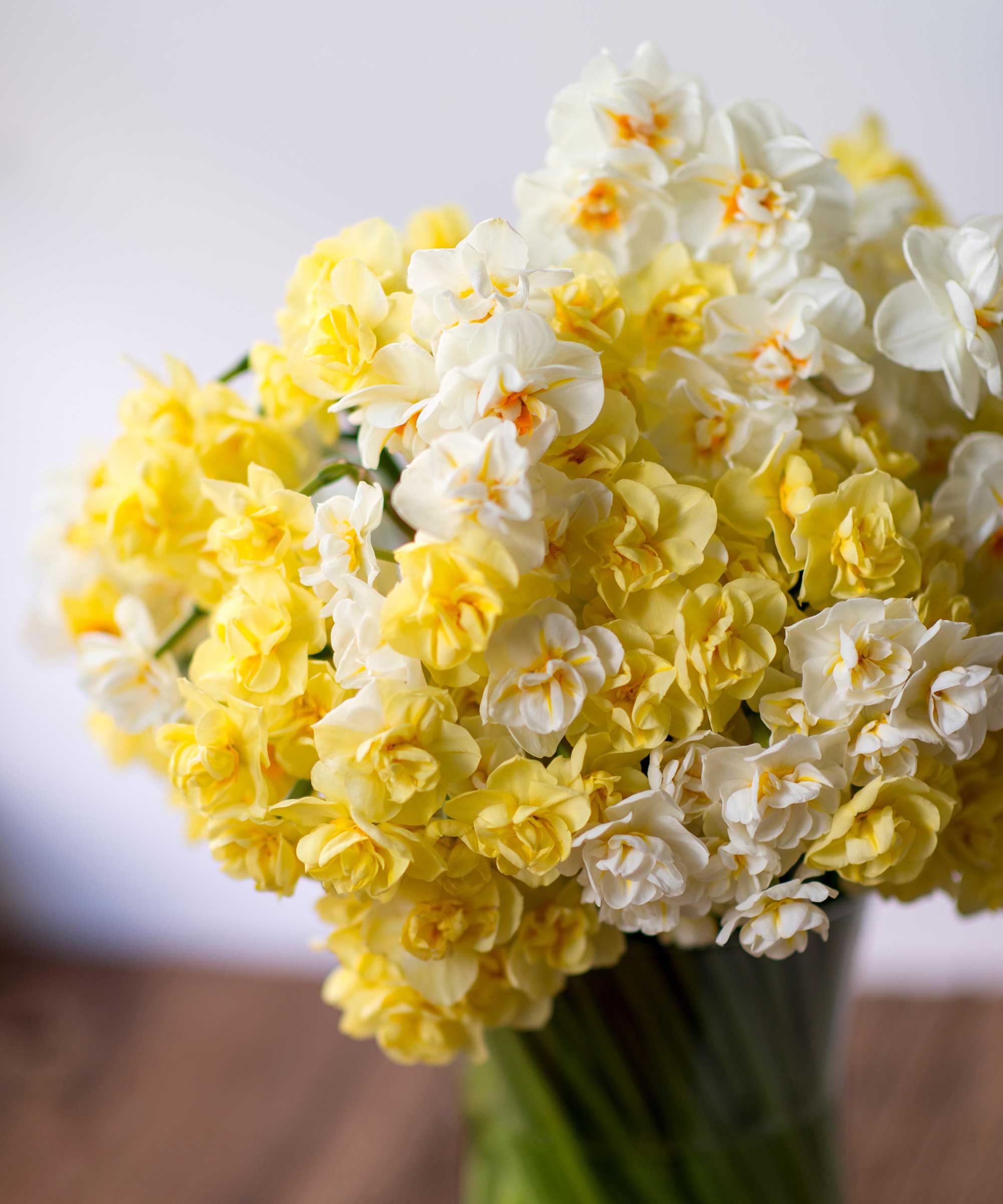
This pretty bouquet of narcissus includes 'Cheerfulness', 'Sir Winston Churchill' and 'Bridal Crown'
What are the best spring bulbs for shade?
If your garden doesn't get much sun, you can enjoy the beauty of some shade-loving, spring-flowering bulbs.
Snowdrops are naturally suited to woodland environments, so thrive in dappled shade and moist but well-drained soil. The delicate spring-flowering anemones are another good option, and some crocuses will flower in part-shade, too.
Although tulips perform best in sunny spots, they will still put on a show in partial shade, as will some varieties of narcissus.
You could also try growing Solomon's seal from bulb, which also does well in shade. It has 'an elegance beyond most perennials,' says Graham Rice, with arching, self-supporting shoots and green-tipped, cream-colored bells followed by black berries. 'But, beware of caterpillars,' he adds. If you don't fancy growing them from bulbs, you can buy them as young plants in the spring.
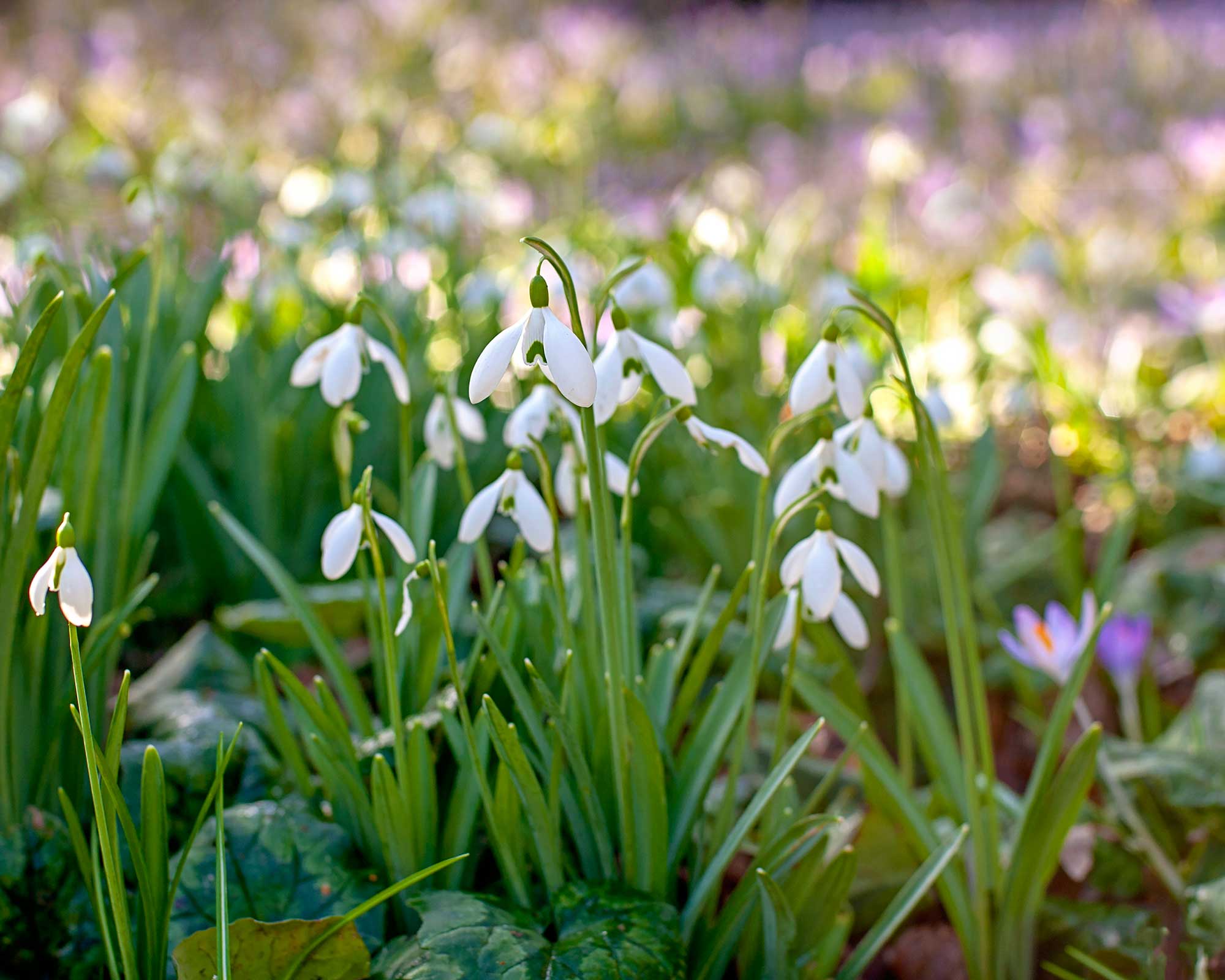
Snowdrops are well-suited to shade
What should you do if your bulbs appear earlier than expected?
Spells of warmer winter weather can lead to spring bulbs emerging and flowering earlier than expected. If this is the case, you may need to protect the bulbs from frost.
'If blooming coincides with a forecast of hard frost, cover plants with fleece to reduce risk of damage,' advises John Negus, a gardening expert from Amateur Gardening.
'Support fleece with a framework of canes or twiggy sticks to avoid it touching leaves and flowers. Remove protection the moment temperatures rise again.'
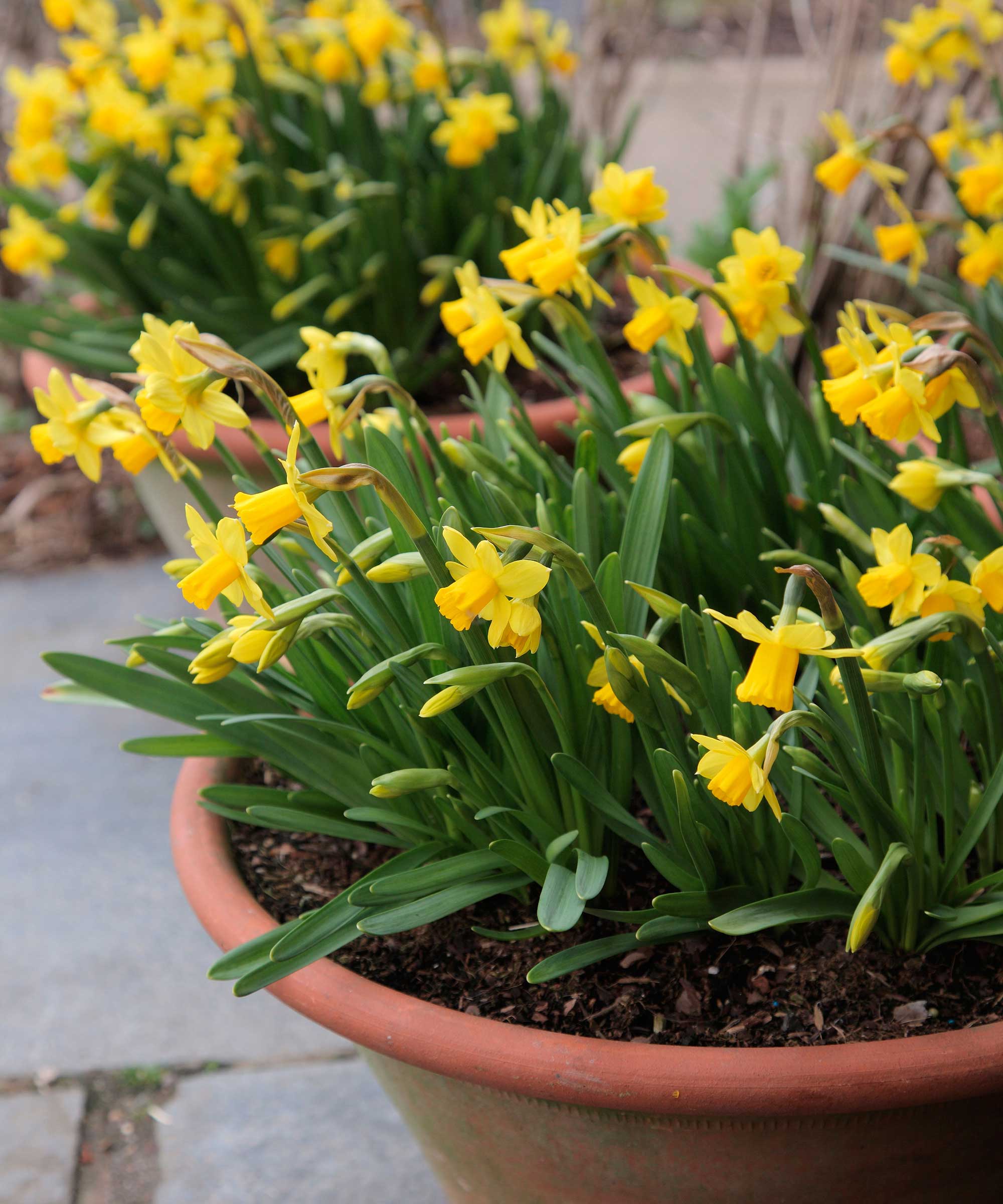
Early-flowering bulbs may need protecting from hard frosts
What should you do with spring bulbs after they have flowered?
'If those bulbs that you planted in a border can be left to naturalize and you are not planning to replace them with other plants, so much the better,' says John. Most will multiply well if left in situ. However, lifting and storing tulip bulbs, as well as hyacinths, is recommended for a better display the following year.
'As for those in containers, I suggest that when they’ve finished flowering you move them to a bed or border to establish well,' continues John.
'Ideally, liquid-feed all plants at weekly intervals with a high-potash tomato fertilizer while leaves are green and perky and before they fade to brown. Don’t cut off or knot the leaves as they are dying back as this will prevent them from returning goodness to the bulbs for the following year’s display.'
Alternatively, remove your bulbs from their containers when the foliage has withered and died back, and store them in a cool, airy place before replanting them in autumn.
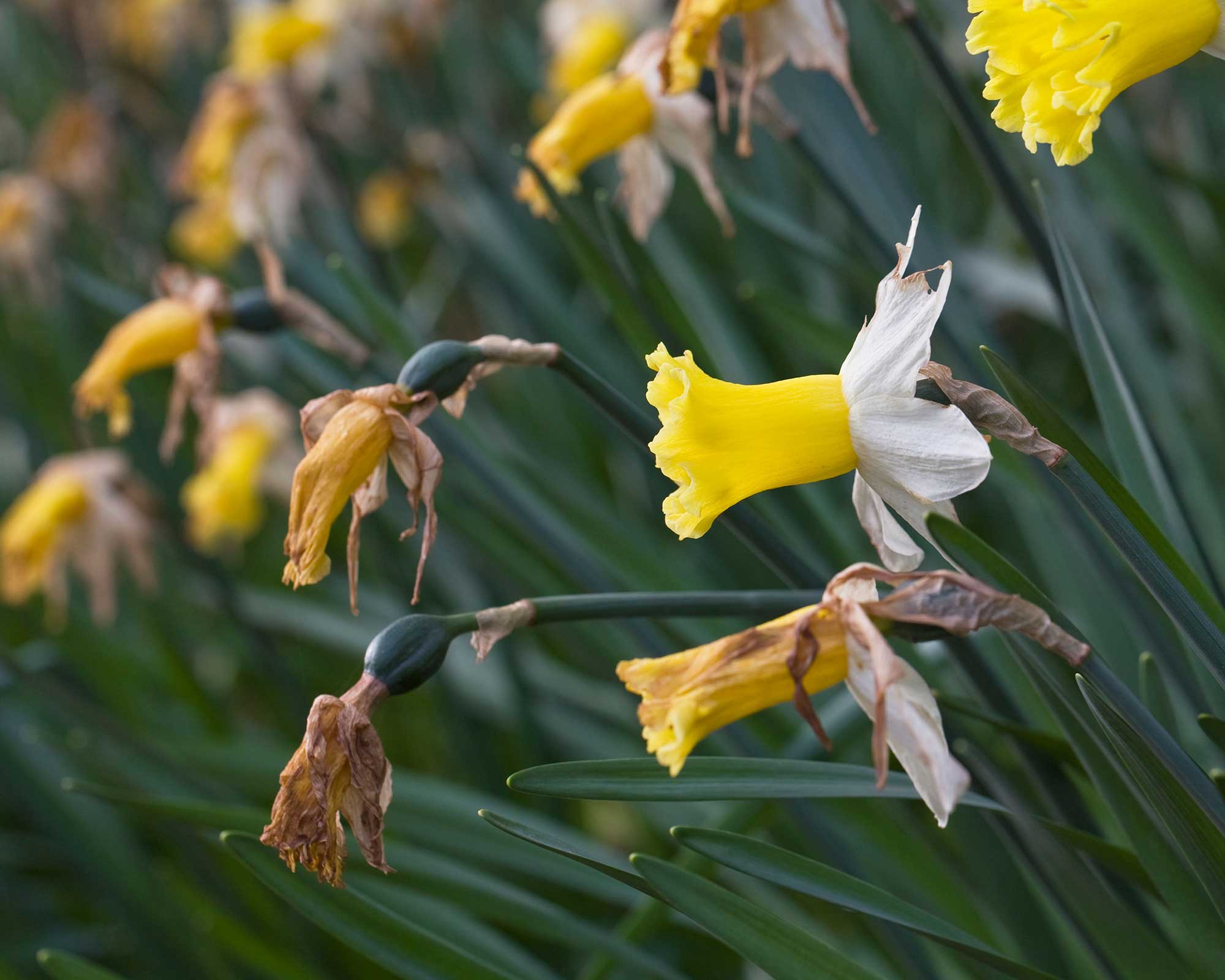
Spring bulbs will die back naturally
What are some common problems with growing bulbs and how do you avoid them?
'Bulbs need well-drained soil,' says John. Wet winters can lead to waterlogged ground, and dampened bulbs are susceptible to fungal diseases.
If you can see white fluffy fungus on your bulbs, they may have caught sclerotinia disease. 'This is caused by the sclerotinia fungus which produces tiny black structures that persist in the soil,' explains John. 'These need wet conditions to grow, and unfortunately there are no chemical controls available.
'To try to get rid of it, first, dig over the bed and make sure it is draining well (add drainage holes and grit if necessary). Remove and dispose of all the infected bulbs, then try a few bulbs for next year to see what happens.'
Sometimes, bulbs fail to produce flowers. Some of the reasons include not planting deep enough, planting in dry soil, and planting too late (daffodils) or too early (tulips), says John.
Other reasons include your bulbs being dug up by squirrels or mice, bulbs not being fed and watered while the leaves are still growing, and the foliage not being allowed to die back naturally and return energy to the bulbs, he adds.
Snowdrops, in particular, are notoriously hard to establish. 'The usual reason is that bulbs are too small to produce flowers,' says John. 'Provided your plants grow strongly this year and bulbs enlarge, they should bloom normally next year.' You can encourage them to bloom by fertilizing the plants with sulfate of potash. Sprinkle it around your plants and water it in in mid-spring and continue to do so, monthly, until early fall.
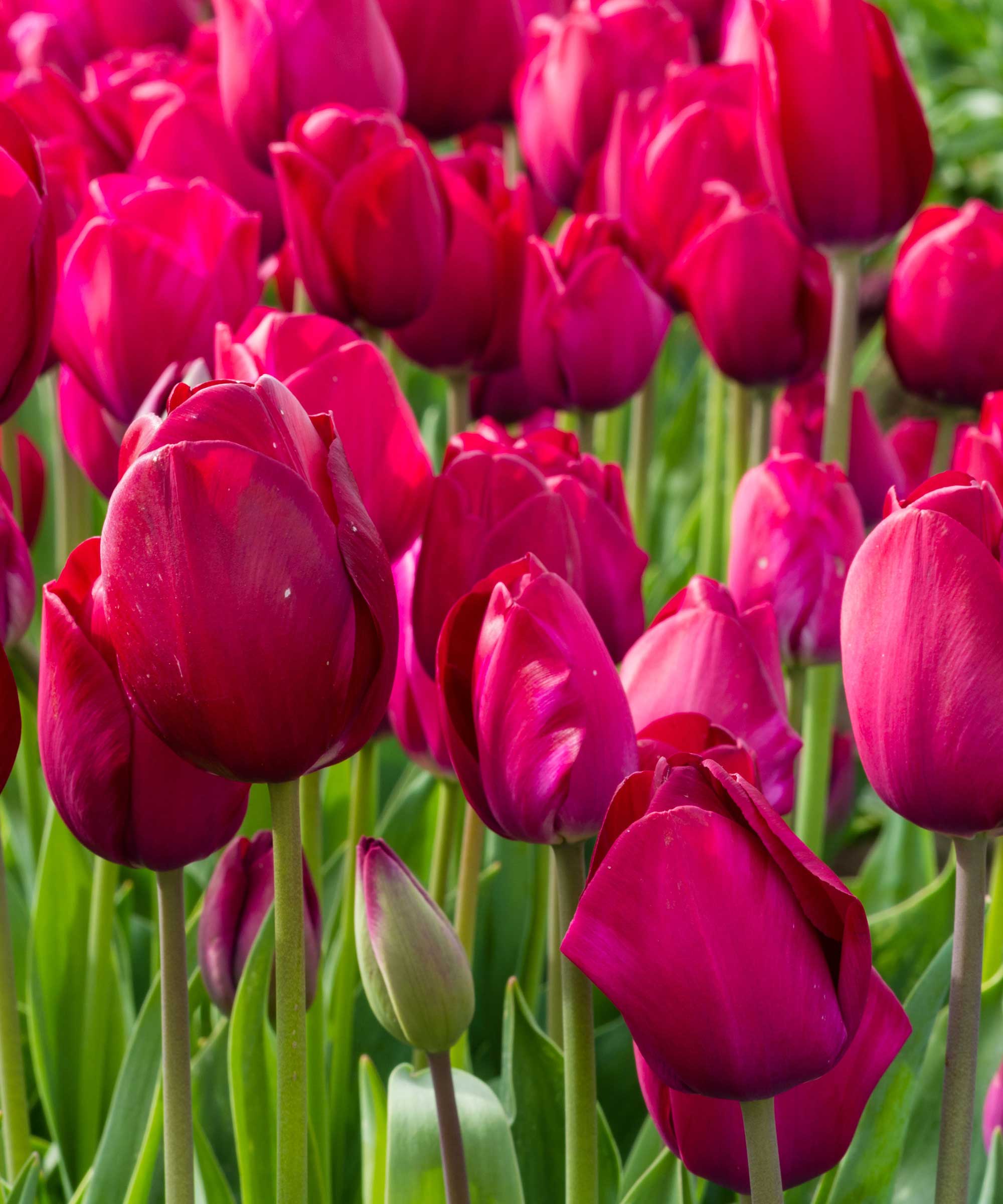
Plant too early, and your tulips may fail to produce the beautiful blooms you expect
Are bulbs toxic to pets?
Most bulbs, including daffodils and tulips, are highly poisonous plants for dogs and cats. So, if you are worried, avoid planting them in your flower beds. A raised container out of their reach may be a safer choice.
5 bulb planting ideas to try in your garden
Whether you're stuck in a bulb planting rut or simply don't know where to start when it comes to planting bulbs in your garden, try these ideas for creating spring displays with a difference.
1. Opt for scented varieties
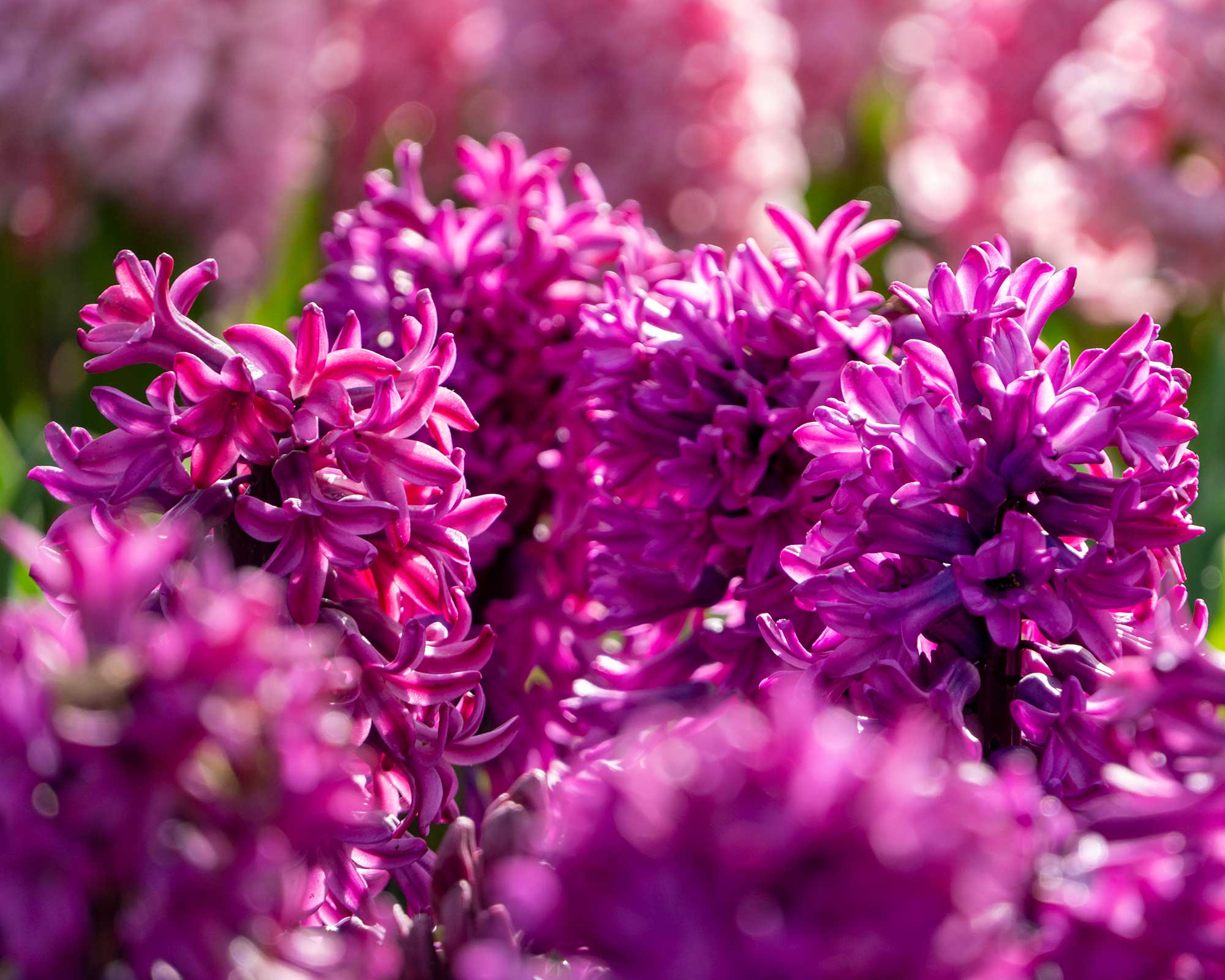
Hyacinths are the most fragrant of all the spring bulbs
Not only are bulbs lovely to look at, but there are some amazingly scented ones too.
Hyacinths are definitely at the top of the list – all have a strong, sweet-yet-spicy fragrance that will fill your garden or home. Muscari (grape hyacinths) also smell sweet, but it's much more subtle.
In terms of scented daffodils, 'Cheerfulness', 'Bridal Crown', 'Thalia' and 'Double Smiles' are some of the very best.
For scented tulips, try 'Foxtrot', 'Apricot Beauty' and the yellow-and-red 'Bellona'. Double tulips (the ones that look a little like peonies) are often scented too – try the pretty pink 'Angelique'.
And don't forget about snowdrops. Some are more scented than others, with Galanthus elwesii – which sports the largest flowers of them all – being the most fragrant with a honey-like scent. They make a great addition to the winter garden.
2. Create waves of continual color
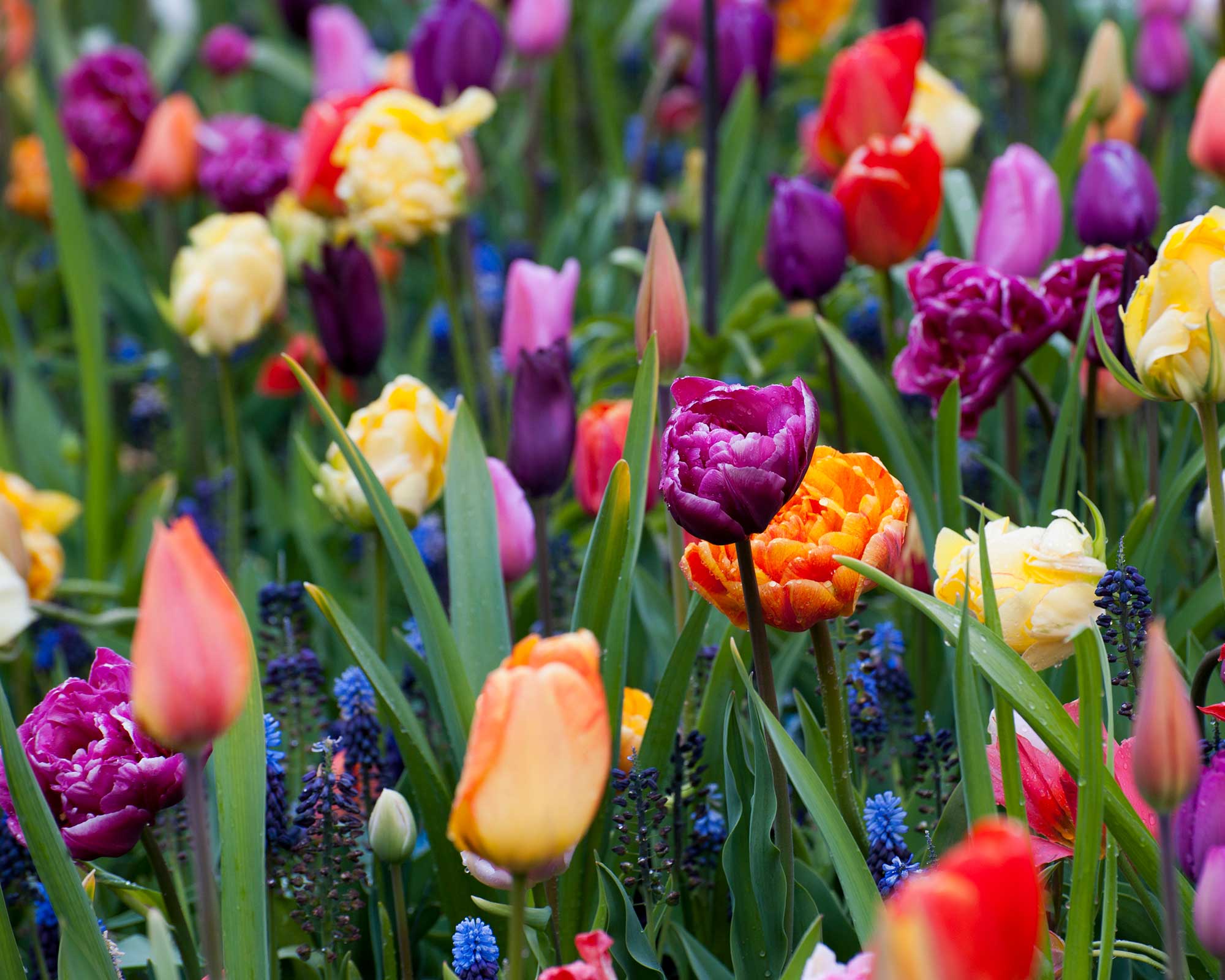
As muscari starts to fade, tulips will take over the show
A good bulb planting trick is to try to make sure you have waves of continual color weaving through your garden from late winter right through to early summer with successional planting.
This means that as one set of bulbs have their final flourish, ideally the next display should be unfurling their petals. Start the year with snowdrops, followed by crocuses. Then, the hyacinths and daffodils take center stage, followed by tulips.
3. Go for mass planting
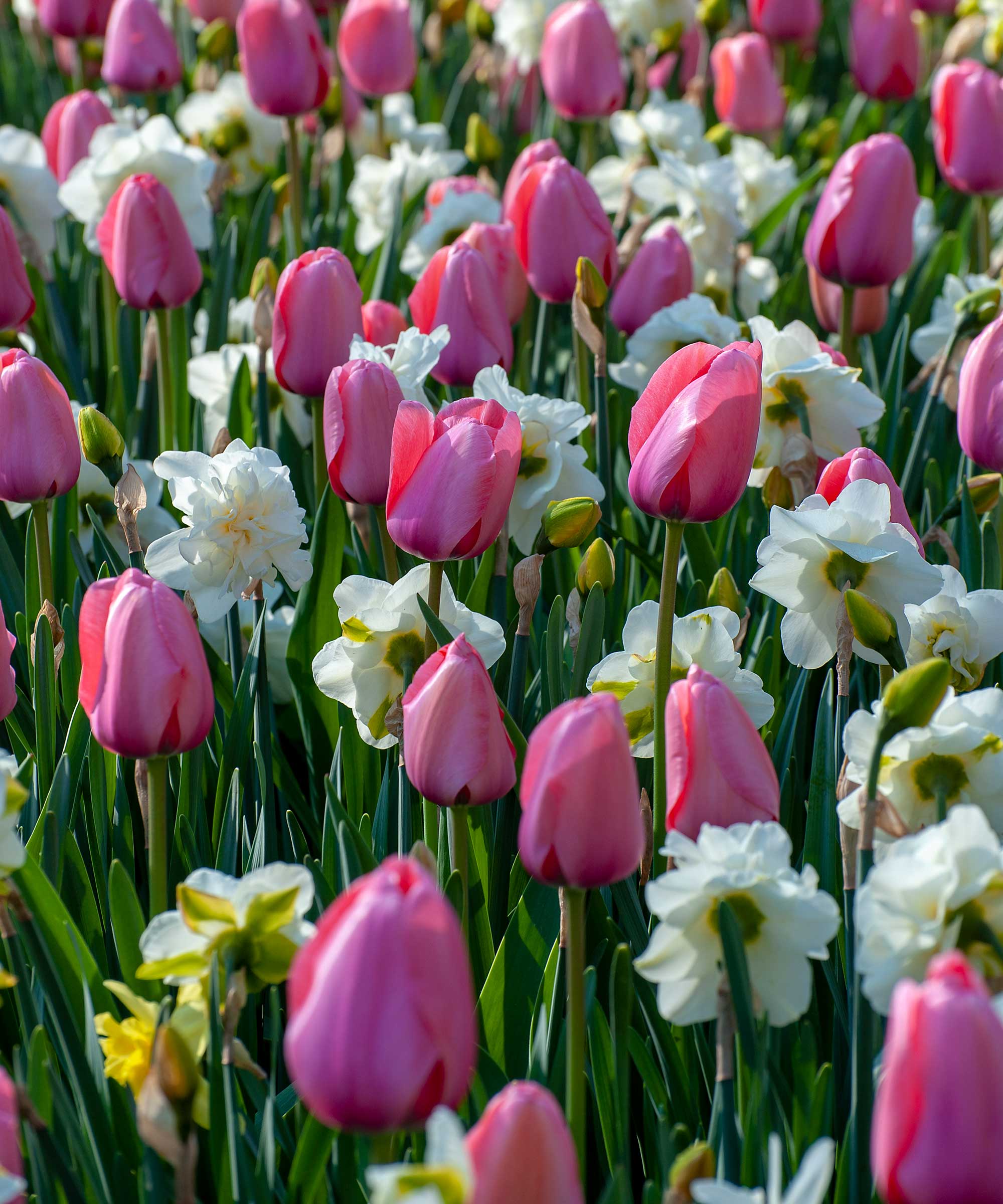
Try sticking to a minimal color palette for a big impact
Planting en masse can create a stunning visual effect in beds and borders as well as lawns. This effect can also be achieved on a smaller scale by grouping several pots or containers together.
Try planting a single color, choosing two or three complementary colors, or underplanting with other spring flowers such as primulas, violas or forget-me-nots.
The size of the planting area will determine how many bulbs are needed, but generally, 25–50 bulbs should be enough to make an impressive show.
4. Plant bulbs to add interest to small spaces
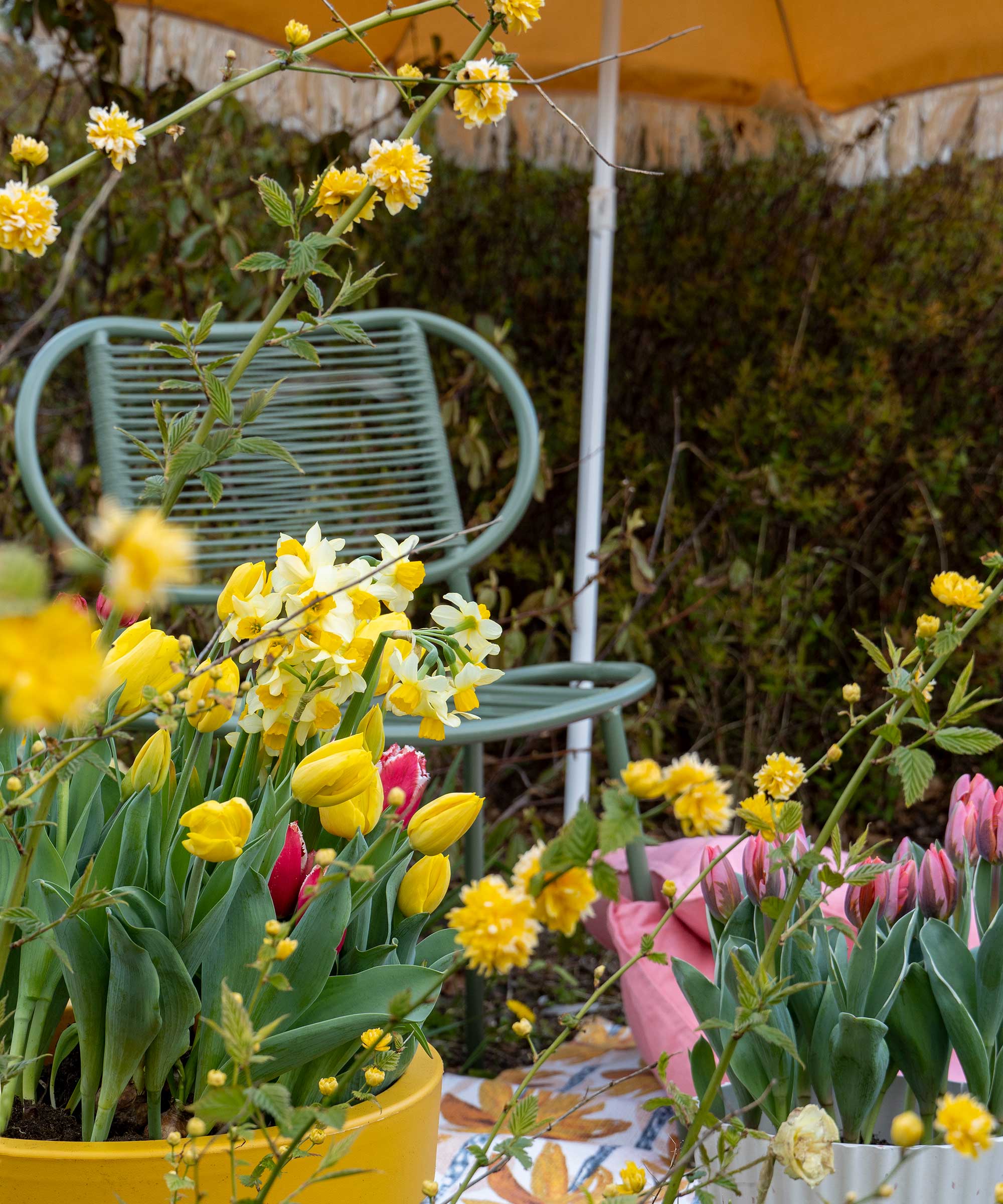
Brighten up a small plot with potted bulbs
One of the benefits to growing bulbs in containers is that you don't need a huge garden to create beautiful displays.
Dwarf varieties such as Iris reticulata; crocus; species tulips such as Tulipa tarda or Tulipa coerulea oculata; Narcissus 'Tête-à-tête', or Narcissus canaliculatus are ideal for growing in small pots on patios or balconies or in window boxes.
5. Try a bulb lasagne
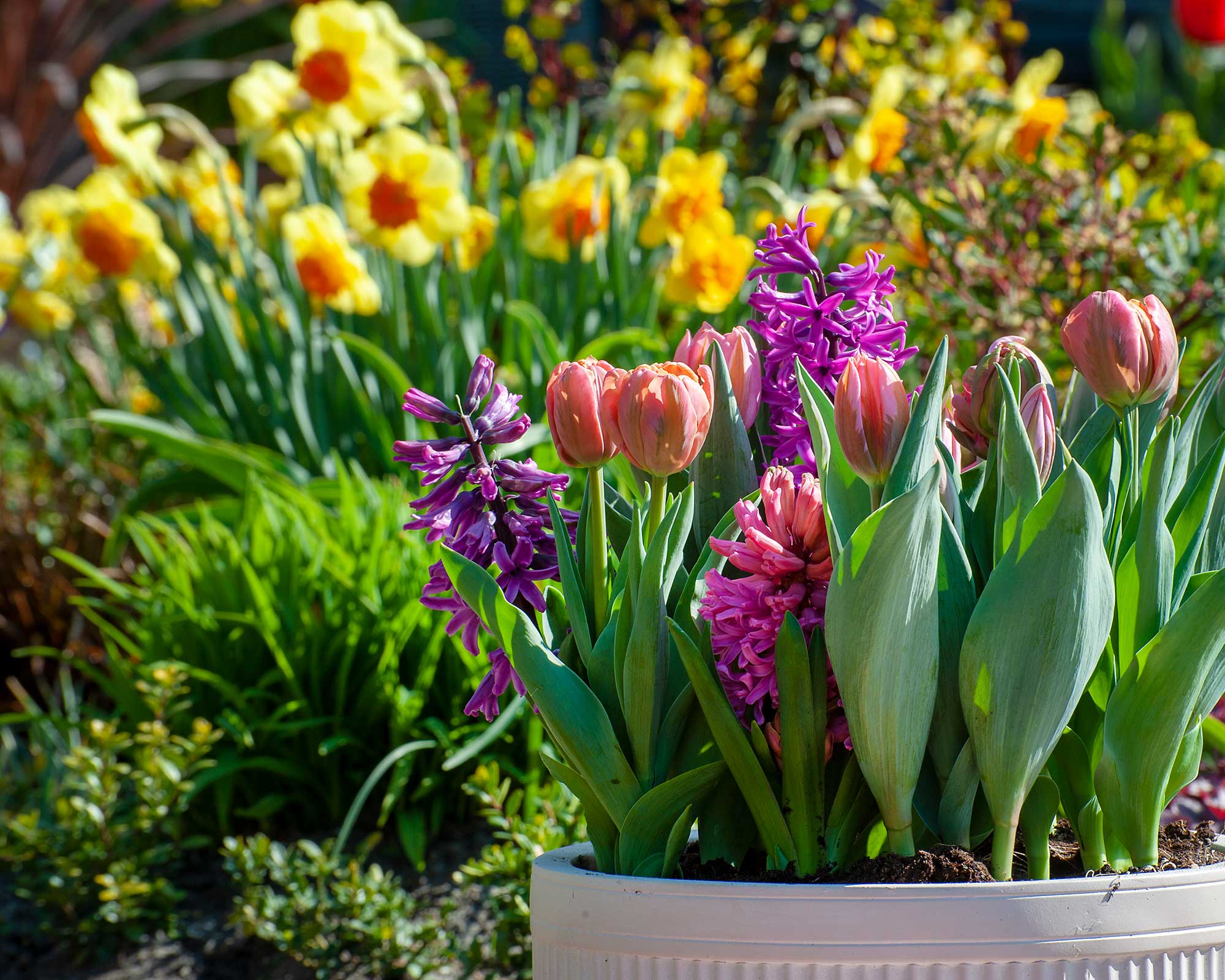
Save on space by layering bulbs
A bulb lasagne is a way of layering spring bulbs that creates a lovely display that lasts for months. They are easy and fun to put together, providing an opportunity to get the creative juices flowing by experimenting with colors and textures. They are also good if space is limited as you get several species in one container.
The key to successful bulb lasagne ideas is to choose bulbs with consecutive flowering periods to give a long-lasting display.
More top tips for planting bulbs
- Always choose bulbs that are plump and firm. Check that they don't have blemishes or signs of rot, too. These are most likely to perform well.
- Don't scrimp on your bulbs. One of the key things to remember when it comes to planting bulbs is not to scrimp on the number of bulbs you plant. If you want to create impact, you can never have enough bulbs. If you were thinking of planting 10 bulbs in a pot the trick is to double it. As long as they’re not touching it will be fine. The same rule applies to the garden. If you want a drift of daffodils in a border, buy twice as many as you think you need.
- Give them a boost. 'Check the needs of each type but, for most, a liquid feed every two or three weeks from flowering time helps fatten up bulbs,' says Graham Rice. ‘Alternatively, a dressing of bonemeal in spring is always worthwhile.'
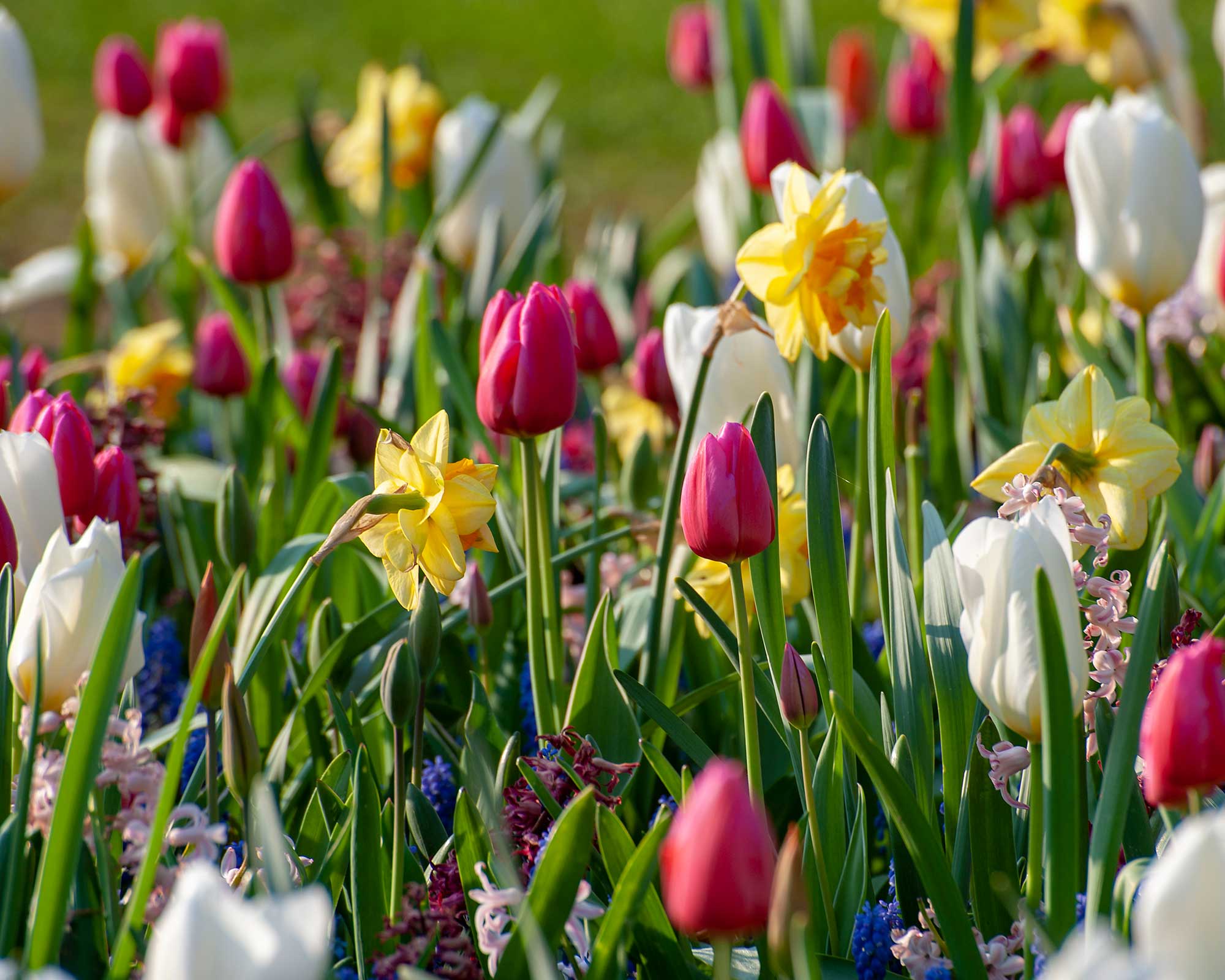
Mix and match your favorites for the best spring display
Where to buy bulbs
Now you've learned all about planting bulbs, you probably want to buy some of your own. Although you can buy them at garden centers in autumn, there are lots of places to buy them online.
Our quicklinks below will help you get started.
Where to buy bulbs in the US:
Where to buy bulbs in the UK:
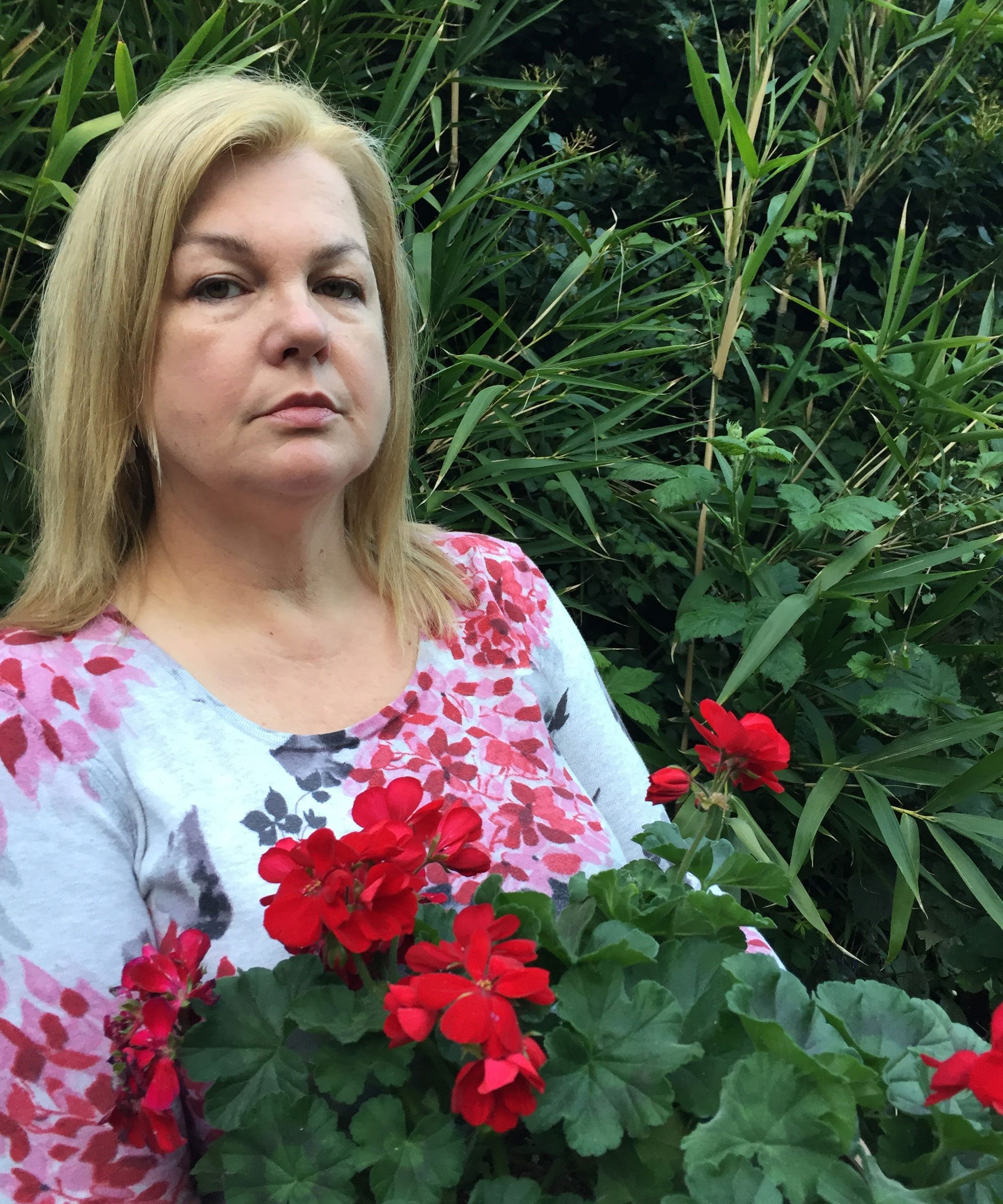
Lifestyle journalist Sarah Wilson has been writing about gardens since 2015. She's written for Gardeningetc.com, Livingetc, Homes & Gardens, Easy Gardens and Modern Gardens magazines. Having studied introductory garden and landscape design, she is currently putting the skills learned to good use in her own space where the dream is establishing a cutting garden.
- Holly CrossleyActing Deputy Editor
